#Ceratopsia
Explore tagged Tumblr posts
Text
Lokiceratops rangiformis Loewen et al., 2024 (new genus and species)
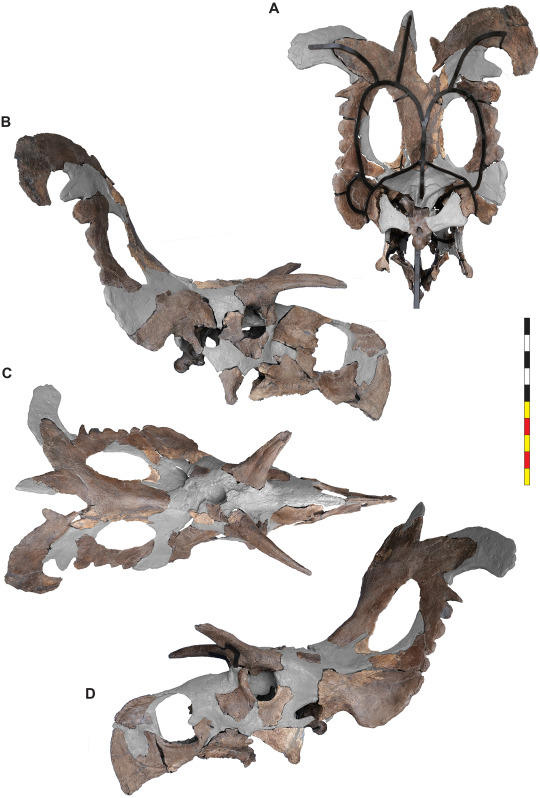
(Reconstructed skull of Lokiceratops rangiformis [scale bar = 1 m], with unpreserved portions in gray, from Loewen et al., 2024)
Meaning of name: Lokiceratops = [Norse deity] Loki's horned face [in Greek]; rangiformis = Rangifer [genus of the extant reindeer]-shaped [in Latin]
Age: Late Cretaceous (Campanian), roughly 78.1 million years ago
Where found: Judith River Formation, Montana, U.S.A.
How much is known: Partial skeleton of one individual, including a partial skull, several vertebrae, and some limb bones.
Notes: Lokiceratops was a centrosaurine cereratopsian, making it a horned dinosaur more closely related to Styracosaurus and Pachyrhinosaurus than to Triceratops. It is one of the largest known centrosaurines, with its skull alone being nearly 2 m long.
The skull of Lokiceratops was highly distinctive. A pair of very large, curved horns at the back of its frill pointed out to the sides. Furthermore, a pair of smaller horns closer to the center of the frill was asymmetrical, with one horn being larger than the other. Asymmetrical head ornamentation is also seen in the antlers of reindeer, hence the species name "rangiformis".
Lokiceratops is known from approximately the same time and location as three other centrosaurines, Albertaceratops, Medusaceratops, and Wendiceratops. Despite their diversity, all centrosaurines discovered so far are only known from very narrow ranges in both time and space. This may suggest that these horned dinosaurs diversified rapidly into numerous forms differentiated primarily by display features such as the shape of their horns and frills, with each species lasting only a short time in a small geographic region before evolving into new species or going extinct.
Reference: Loewen, M.A., J.J.W. Sertich, S. Sampson, J.K. O’Connor, S. Carpenter, B. Sisson, A. Øhlenschlæger, A.A. Farke, P.J. Makovicky, N. Longrich, and D.C. Evans. 2024. Lokiceratops rangiformis gen. et sp. nov. (Ceratopsidae: Centrosaurinae) from the Campanian Judith River Formation of Montana reveals rapid regional radiations and extreme endemism within centrosaurine dinosaurs. PeerJ 12: e17224. doi: 10.7717/peerj.17224
424 notes
·
View notes
Text

A typical morning scene in the redwood forests of what is now the Hell Creek Formation, 68 million years ago
#paleoart#dinosaur#dinosaurs#paleontology#palaeontology#palaeoart#triceretops#triceratops prorsus#dinosaur art#dinosaur artwork#ceratopsian#ceratopsians#ceratopsia#dinosauria#mesozoic#hell creek#hell creek formation#late cretaceous#maastrichtian
116 notes
·
View notes
Text
Time Travel Question 38: Pre-History Continued
These Questions are the result of suggestions from the previous iteration.
This category may include suggestions made too late to fall into the correct earlier time grouping. Basically, I'd already moved on to human history, but I'd periodically get a pre-homin suggestion, hence the occasional random item waaay out of it's time period, rather than reopen the category.
In some cases a culture lasted a really long time and I grouped them by whether it was likely the later or earlier grouping made the most sense with the information I had. (Invention ofs tend to fall in an earlier grouping if it's still open. Ones that imply height of or just before something tend to get grouped later, but not always. Sometimes I'll split two different things from the same culture into different polls because they involve separate research goals or the like).
Please add new suggestions below if you have them for future consideration. All cultures and time periods welcome.
#Time Travel#Friesenhahn Cave#Homotheriums#Mammoth#Megafauna#Pre-History#Ceratopsia#Dinosaurs#Carboniferous#Insects#Evolution#Jellyfish#Sea Creatures#Spinosaur#Hallucigenia#Lepidodendrons#Extinct Plants
60 notes
·
View notes
Text
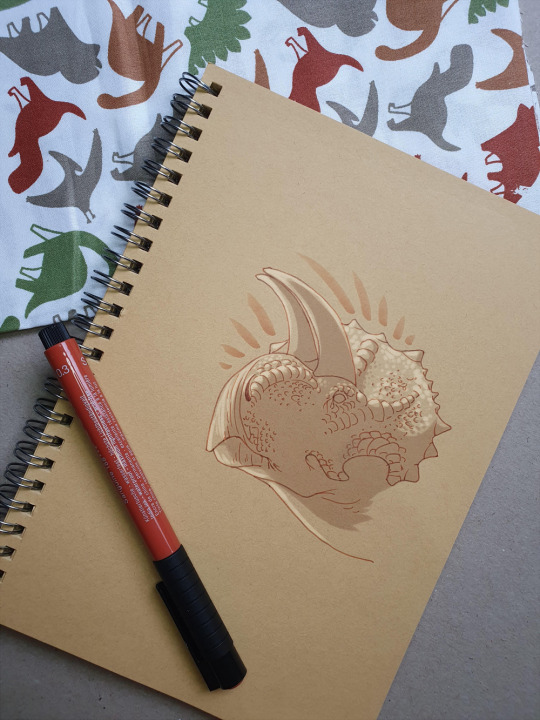
Day 2: Furcatoceratops elucidans
#paleoart#art#dinosaur#prehistoric#paleontology#digitalart#traditionalart#Archovember2023#Dinovember#Dinovember2023#DrawDinovember#DrawDinovember2023#Furcatoceratopselucidans#Furcatoceratops#Nasutoceratopsini#Centrosaurinae#Ceratopsia#archovember#palaeontology
61 notes
·
View notes
Text

Day 2: Kosmoceratops
But with memory vs. reference in lineart.
Do not use my art as base or something like that.
#my art#dinosaur#paleoart#myart#dinosaurs#dinosauria#my drawings#ornithischia#ceratopsia#ceratopsidae#Kosmoceratops#chasmosaurinae#dinocember#sketchbookapp#sketchbook app
43 notes
·
View notes
Text




monthly giveaway freebies for kofi members! ✧.* kofi || monthly tiers・゜゜・.
14 notes
·
View notes
Text

Here's the piece I did for the Primeval Age anniversary event quest, Island Parade!
[Image description: A stylized digital drawing of a young brown styracosaurus with bright blue eyes & pale freckles all over, standing to the side with a devious smile, his head lowered so his nose horn is pointed directly in front of him. End of image description]
In hindsight I would've liked to leave the outline black & only color the lines within the silhouette so he'd look better on a dark background, but oh well. I don't know what kind of background they're going to put him on, and he's dark enough in color that he's probably going to look fine!
#primeval age#feral art#digital art#my art#fawnrats art#paleoart#styracosaurus#ceratopsidae#ceratopsia#dinosaur#non-avian dinosaur#art
7 notes
·
View notes
Note
Speaking of spiffy dinosaurs i think ceratopsians in general are among the spiffy-est
Oh that's definitely true! They really are spiffy
21 notes
·
View notes
Text
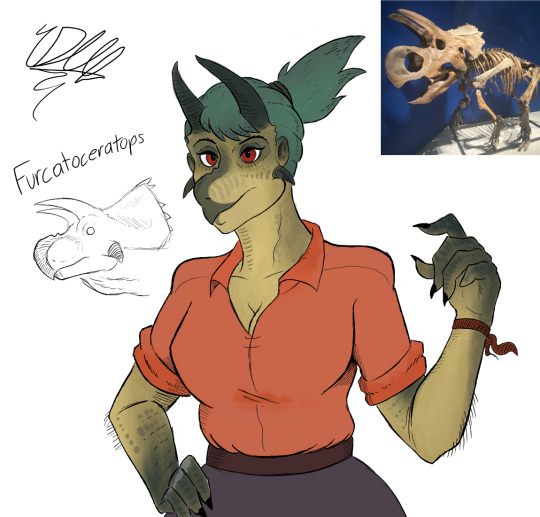
Concept for a Furcatoceratops dinosauroid, stylized to look like the other dinosauroids I've made, so its got that mutant look to it.
#art#artwork#artists on tumblr#colorful#dinosaur#character art#character concept#original character#dinosauroid#dinosaur oc#horns#scales#anthro#furcatoceratops#ceratopsia#dinosaurs#monster girl#monster gal#dinosaur girl
16 notes
·
View notes
Text
Microceratus gobiensis, one of the smallest ceratopsians, and Pentaceratops sternbergii, one of the largest ceratopsians. I made both of these simultaneously, and decided to include them in the same post.
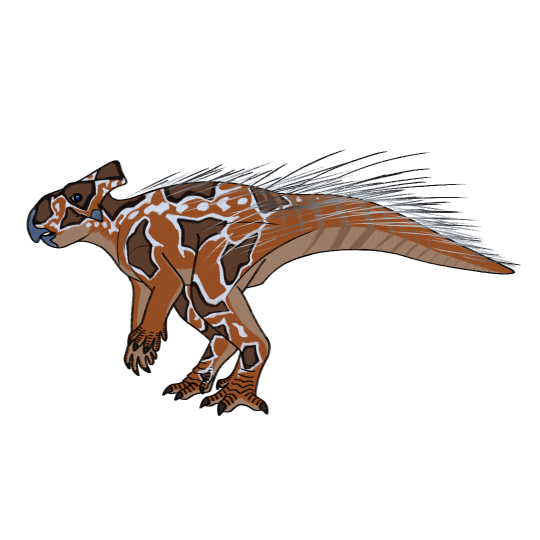

With Hatsune Miku for scale:


#microceratus#pentaceratops#ceratopsian#ceratopsidae#ceratopsia#dinosaur#dinosaurs#digital doodle#digital doodles
19 notes
·
View notes
Text
Auroraceratops rugosus

Auroraceratops was a genus of neoceratopsian dinosaur from the Early Cretaceous period. Its type species is Auroraceratops rugosus. The first specimen was found in the Xinminpu Group of Gansu Province, China. As of 2021, fossils from over 80 different individuals have been recovered, ranging from fragments to complete skeletons.
Its autapomorphies include noticeably large nasals; fungiform expansion of the dorsal end of the lacrimal; a significantly rugose jugal, dentary, and surangular; horizontal caudally-directed processes of the pterygoid ventrally covering the base of the skull; and large, striated premaxillary teeth.
Auroraceratops was a small, bipedal herbivore, sporting a large head with a small, bony frill and a beak. It had five toes on its front legs and four on its hind legs. It may possibly be closely related to either Yamaceratops or Graciliceratops.
Original paper: ou, H.; Li, D.; Ji, Q.; Lamanna, H.; Dodson, P. (2005). "On a new genus of basal Neoceratopsian dinosaur from the Early Cretaceous of Gansu Province, China". Acta Geologica Sinica. 79 (5): 593–597.
Wikipedia article: https://en.m.wikipedia.org/wiki/Auroraceratops
#dinosaur#dinosuaria#paleoart#paleontology#artwork#original art#human artist#auroraceratops#neoceratopsidae#ceratopsia#ceratopsian#obscure fossil animals#obscure fossil dinosaurs#obscure fossil tetrapods
15 notes
·
View notes
Text
Sasayamagnomus saegusai Tanaka et al., 2024 (new genus and species)

(Reconstructed skull of Sasayamagnomus saegusai [scale bar = 2 cm], from Tanaka et al., 2024)
Meaning of name: Sasayamagnomus = Sasayama Basin gnome [in Latin]; saegusai = for Haruo Saegusa [Japanese paleontologist who passed away in 2022]
Age: Early Cretaceous (Albian), between 106.4–112.1 million years ago
Where found: Ohyamashimo Formation, Hyōgo, Japan
How much is known: Remains of at least two individuals, together representing part of the skull and a couple of limb bones.
Notes: Sasayamagnomus was a ceratopsian. Although ceratopsians are best known for the large, horned ceratopsids (such as Triceratops), they also include a wide variety of generally smaller forms that lacked obvious horns, including this new species. Sasayamagnomus appears to have been closely related to Aquilops, another hornless ceratopsian that lived in North America at around the same time, and is the first definitive ceratopsian to be named from Japan. (The taxonomically controversial Albalophosaurus may represent another Japanese early ceratopsian.)
Reference: Tanaka, T., K. Chiba, T. Ikeda, and M.J. Ryan. 2024. A new neoceratopsian (Ornithischia, Ceratopsia) from the Lower Cretaceous Ohyamashimo Formation (Albian), southwestern Japan. Papers in Palaeontology 10: e1587. doi: 10.1002/spp2.1587
146 notes
·
View notes
Text

Keiko and the Magnificent Pentaceratops -
Robby Hide and Vicky both watch in awe as Keiko bonds with an imposing forest spirit who comes in the form of a giant Pentaceratops (or Titanoceratops).
#dinosaur#paleoart#dinosaurs#paleontology#fantasy#palaeontology#sorceress#keiko#palaeoart#dinosaur art#concept artwork#conceptart#concept art#high fantasy#nature spirits#nature spirit#forest spirit#pentaceratops#ceratopsians#ceratopsian#hatzegopteryx#the sorceress of leaf and sand#fantasy concept#fantasy concept art#fantasy art#fantasy artwork#ceratopsia#paleontologyart#paleofantasy
54 notes
·
View notes
Text
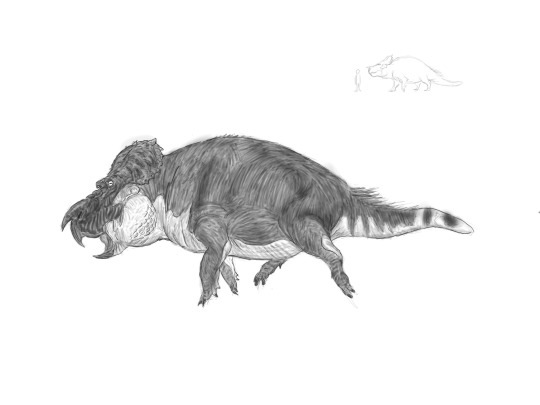
Aurungo-Pundapi (artwork by Yuujinner)
Kingdom: Animalia Phylum: Chordata Class/Clade: Reptilia (Sauropsida) Clade: Diapsida Clade: Archosauria Clade: Dinosauria
Order: Ornithischia
Clade: Marginocephalia
Suborder: Ceratopsia
Family: Ceratopsidae
Subfamily: Centrosaurinae
Clade: Eucentrosaura
Tribe: Centrosaurini
Genus: Deinoceratops
Species: D. susoides (”pig-like terrible horned face”)
Ancestral species: Centrosaurus apertus
Time period: Pleistocene to modern day (1.5 million years to present).
Information:
In the eastern swamps of the Isle of Perils, we encounter a most bizarre species: Deinoceratops susoides (“pig-like terrible horned face”), better known by its Xenogaean name, the aurungo-pundapi, “the one whose face is adorned with scars”.
A centrosaurine ceratopsid, the aurungo-pundapi is unusual not only in its semiaquatic habits, not unlike those of a hippopotamus, but also its diet: an omnivore, this creature eats mostly aquatic vegetation like reeds and lilies, but it also eats, among other things, carrion, fish, and the young of other dinosaurs, and it may even go after small crocodylomorphs in its habitat. Of course, as an animal which shared its habitat with other large meat-eaters, including rhizodonts and theropods many times larger than it, the aurungo-pundapi is quite territorial: this animal will usually rush at attackers first and ask questions later, and it is so widely-feared for its ferocious temper, that early European explorers in the region dubbed it the “lizard-hippo” in reference to its similar size, niche, and temperament to its namesake. However, unlike the hippopotamus of Africa, the aurungo-pundapi’s aggression frequently extends to its own species to the point where no two animals will ever congregate within the same stretch of water outside of the mating season. During late June and throughout early July, the males are at their most aggressive: during this time, they enter a state similar to musth in male elephants wherein their hormones spike, causing them to become highly aggressive towards other animals. It was during one such mating season in 1938 that a bull aurungo-pundapi went on a rampage in a village in the marshlands, killing many livestock and people alike before it was finally shot and killed by the villagers. As this animal’s bulk (which is actually comprised mostly of lean muscle instead of fat) makes it difficult for this animal to move efficiently on land, mating usually occurs in the water, which is made possible thanks to the animal’s ability to hold its breath for nearly 2 hours at a time. After the pair have mated, they go separate ways and in a few weeks time, the female will lay her clutch of around 4-8 eggs in a small nest on land which she will visit regularly, removing and adding dirt regularly as needed. In another month, the young will hatch, and for the first few years of their life, they will be dependent on her for protection until they are big enough to fend for themselves, after which she will chase them off. By age 10, they will have reached full size and by age 14, they will have reached sexual maturity, and by this point in their life, few predators will ever dare to harm them. Thus, a healthy aurungo-pundapi can expect to live to a ripe old age of 60-70 years.
This is a revamped version of an old, old creature!
#speculative evolution#novella#fantasy#scifi#scififantasy#speculative biology#speculative fiction#speculative zoology#worldbuilding#dinosaur#ceratopsian#ceratopsia#ornithischians#fantasy creature#sci fi creature#archosaur#spec evo#creature design#creature art#sci-fi creature
4 notes
·
View notes
Text

Day 27: Udanoceratops tschizhovi
#paleoart#art#dinosaur#prehistoric#paleontology#digitalart#traditionalart#Archosaur#Archovember2023#Archovember#Dinovember#Dinovember2023#DrawDinovember#DrawDinovember2023#Udanoceratops#Udanoceratopstschizhovi#Leptoceratopsidae#Ceratopsia#paleoblr#palaeoblr#digital art
42 notes
·
View notes
Text

Happy 4th of July everyone, here’s a quick sketch, inked and painted a basal ceratopsian Aquilops americanus for Independence Day.
#my art#dinosaur#paleoart#myart#dinosaurs#my drawings#dinosauria#sketchbookapp#fourth of july#4th of july#artists on tumblr#aquilops#ceratopsian#ceratopsia#ornithischians#ornithischia
12 notes
·
View notes